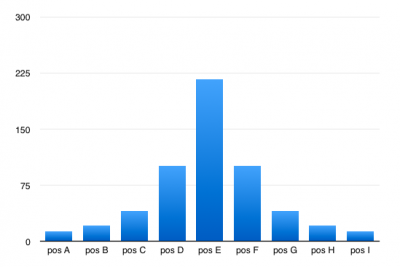In this post, I’d like to make an argument about a way to understand how the Democratic party seems to be making messaging and policy decisions. An argument like this can’t be made in a vacuum—or in 1,500 words. Nor can any one or even ten reasons be decided upon for why the leaders of a party do what they do. But I recognize a pattern in how the DNC and leadership has acted over the past decade and I want to work that through here. So please forgive any indication that I am not a policy wonk or political analyst—I do not claim to be, nor do I wish to be either.
In my series on the history of the Quantified Self and eugenics earlier this year, I referenced the Belgian astronomer, Adolphe Quetelet, who argued that man could be measured just like the positions of planets. I didn’t have the space to explain it very well back then, but think about it like this: you and, say, 570 of your closest friends have telescopes. At the same time on the same night, you each measure the position of a certain star in the sky. You all come up with roughly the same position, but with distinct and consistent variation. Take those measurements and plot them along a chart, like this:
The numbers of measurements that fall into position A (14 friends got this measurement), B (21), C (41), etc. is counted and plotted. The astronomer’s error law, normal distribution, and Gaussian density function (which are all the same thing) dictate that these values will fall into the normal bell curve. Most of the measurements (217) fell at position E, which means that your friends who got other measurements were probably wrong. So let’s say that the star you’re measuring is, in fact, at position E.
Now, let’s assume that instead of 571 people taking the same measurement, it’s just you but you’re measuring the height of 571 people. Quetelet would argue (in fact, he did just this in 1842) that the heights of these people (he would call them men…because they were) would fall into the same normal distribution. And, just like position E on the above graph revealed the “real” position of the star, position E on our height graph would reveal the “real” height of a man. After compiling a good number of measurements about this man, he labeled him l’homme moyen, the average man.
Remember that this was all happening in the mid-1800s in France and Belgium, a time during which the French monarchy was under upheaval. In 1830, Charles X was forced to abdicate after the July Revolution, and so his cousin, Louis Philippe, became king. Louis Philippe (whose daughter was married to Leopold I, king of Quetelet’s home nation Belgium) operated under “a juste milieu, in an equal distance from the excesses of popular power and the abuses of royal power” (Antonetti 1994, p 713). Quetelet, often quoting Victor Cousin and the philosopher’s ideal of moderation and compromise, was quite taken by this idea of juste milieu and equally enthusiastic about the application of the astronomer’s law as an instrument of social analysis: that there is a common type of man and that, just like the “real” position of the planet or the “real” height of man, that type is found somewhere in the middle of the bell curve. Per Ted Porter (1988), “L’home moyen, then, was not just a mathematical abstraction, but a moral ideal” (103). Quetelet believed that income inequality could be tied to crime rates, that the rich lived longer because they did not drink as much, and that moderate men tempered their passion and helped regulate birth and death rates. By smoothing out the curves that described man, oscillations of the social body were eliminated and an ideal existence could be achieved.
What, then, does this have to do with the Democratic Party? It is a relatively well-known history that the Dems (that is, DNC-sanctioned campaigns for legislative and executive offices) have been basing much of their decisions on a sophisticated data operation. As Daniel Kreiss described last February on this blog, starting after the failed 2004 presidential election, the DNC began to build and amass a sophisticated database of constituent and voter information. In The Audacity to Win, 2008 Obama campaign manager David Plouffe elucidates how critical projects like the DNC’s (and the campaign’s own data and media programs1) helped the campaign understand which issues voters wanted to hear about, what geographic areas to focus on—down to the precinct level, and which ads to run when. Reportedly, the 2016 Clinton campaign leaned too heavily on their data, eschewing opportunities to campaign in what would eventually prove to be critical markets…like all of Wisconsin.
Obama won on a centrist platform of compromise, one that led to increased civil freedoms like the right to marry, but his tenure as president also saw large banks and corporations make exponential gains thanks to a largely hands-off approach to post-bailout repercussions. And while the ACA is an extremely critical step in the right direction, it is a far cry from a single-payer healthcare system. On the other hand, the Republican party has enjoyed control of both houses of congress ever since 2010 and conservative extremism has taken hold of all three branches of government after Clinton’s centrist platform could neither carry her, nor her down-ticket colleagues to office. Meanwhile, in England, we’ve observed an oscillation from one extreme—Thatcherism—to the other—Corbyn-inspired Socialism. What might have been considered the “mainstream” Labour party two years ago failed miserably, running on, yes, another centrist platform—even with the help of Obama’s 2008 and 2012 strategy, data, and media team.
Francis Galton, you may remember from the first installment of my eugenics series, took Quetelet’s work and shifted it—literally. Rather than seeking to find the normal man and make him the model, the father of eugenics wanted to work against what he considered to be a “reversion to mediocrity.” So he promoted the reproduction of those on the exceptional edge of the bell curve and…gently suggested that those on the “deficient” end not reproduce. Of course, this suggestion manifested itself in forced sterilization programs that lasted well into the 1970s in the United States. The idea, of course, was that by removing the deficient and growing the exceptional, the entire curve is forced to move to the right—to the highest IQs, longest legs, fastest reaction times.
Let’s, for the sake of argument, go ahead and call the Republican party Galtonian. Sure, the AHCA, the travel ban, the removal of LGBT identity from the census, and all of the other appalling policies in place or being put in place have eugenicist characteristics. But for now, I want to argue that the Republican party has been using an edge case messaging strategy: war with the terrorists on our soil is imminent, so keep them out and arm yourselves; you might get rich, so let’s reduce the top-earners’ taxes; your marriage will be ruined by someone else’s decisions; women get abortions for fun and your daughter is next. Meanwhile, the Democrats want to reach across the aisle and find a happy medium. They want to incorporate the insurance companies’ wishes into the ACA. Bankers are people, too. We’ll never get single-payer or free college tuition or comprehensive gun control done because the “average American voter” doesn’t want it.
I don’t get to see the data that DNC or GOP operatives have. Nor do I believe one side won or lost solely on the quality or quantity of its data. I have some idea, albeit nascent, why the Democrats refuse to come down hard for social programs that are primarily beneficial for the populous over the corporations (hint: Republican candidates aren’t the only rich ones out there). But I do know that the July Monarchy of Louis Philipe only lasted 18 years, during which he survived seven assassination attempts. It’s time to push towards the other end of the bell curve—to shift the message to a polarized edge case: single-payer is the only just system, free education will lift everyone, top earners owe more to society than vice versa and should pay their share, guns do kill people. If the Democratic party wants to continue to let the data dictate the policy, they will never move beyond a juste milieu. They will point to l’homme moyen and say, “this is our target.” The problem is that target is moving and unless they take control, then thanks to a general apathy surrounding and rejection of their candidates, it will continue to move to the right.
1In the interest of full disclosure, I worked for a year at Blue State Digital, though not on the Obama or Clinton campaigns, nor does anything I write here violate any sort of non-disclosure agreement.
Gabi Schaffzin is a PhD student at UC San Diego. On this, America’s celebration of independence from the British, he wants you to know that Bernie would have won.


